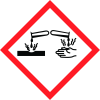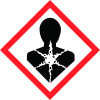3M Scotch-Weld Epoxy Structural Adhesive DP410 Off-White: Part A
3M South Africa (Pty) Ltd
Revision date : 2023-02-08



Note: Ingredients listed on restricted chemical lists
EC/CAS
1675-54-3
Name of the chemical
2,2'-[(1-methylethylidene)bis(4,1-phenyleneoxymethylene)]bisoxirane
Concentration
30-70 0-30
EC/CAS
90-72-2
Name of the chemical
2,4,6-tris(dimethylaminomethyl)phenol
Concentration
0-13
General Information
Version
5.00
Revision date
2023-02-08
Product name
3M Scotch-Weld Epoxy Structural Adhesive DP410 Off-White: Part A
1.2.1 Relevant identified uses
Accelerator for two-part epoxy structural adhesive., Structural adhesive
Supplier name
3M South Africa (Pty) Ltd
Icons in SDS
Company Information
Company name
3M South Africa (Pty) Ltd
GHS Information
Signal word
Danger
Hazard Codes
Hazard statements (CLP)
H302, H313, H314, H317, H370, H412
Hazard statements
Code
Statements
H302
Harmful if swallowed
H313
May be harmful in contact with skin
H314
Causes severe skin burns and eye damage
H317
May cause an allergic skin reaction
H370
Causes damage to organs
H412
Harmful to aquatic life with long lasting effects
Precautionary statements
Code
Statements
P260
Do not breathe dust/fume/gas/mist/vapors/spray.
P303+P361+P353
IF ON SKIN (or hair): Take off Immediately all contaminated clothing. Rinse SKIN with water [or shower].
P305+P351+P338
IF IN EYES: Rinse cautiously with water for several minutes. Remove contact lenses if present and easy to do - continue rinsing.
P310
Immediately call a POISON CENTER or doctor/physician.
P321
Specific treatment (see ... on this label).
P333+P313
IF SKIN irritation or rash occurs: Get medical advice/attention.
Section 2
SECTION 2: Hazards identification
Classification of the substance or mixture Acute Toxicity (oral): Category 4 Acute Toxicity (dermal): Category 5 Skin Corrosion/Irritation: Category 1B Serious Eye Damage/Irritation: Category 1 Skin Sensitizer: Category 1 Specific Target Organ Toxicity (single exposure): Category 1 Acute Aquatic Toxicity: Category 3 Chronic Aquatic Toxicity: Category 3
Hazard pictograms
Corrosion |Exclamation mark |Health Hazard |
Hazard statements
H302 Harmful if swallowed. H313 May be harmful in contact with skin. H314 Causes severe skin burns and eye damage. H317 May cause an allergic skin reaction. H370 Causes damage to organs: blood or blood-forming organs. H412 Harmful to aquatic life with long lasting effects.
Prevention
P260 Do not breathe dust/fume/gas/mist/vapours/spray. P280D Wear protective gloves, protective clothing, and eye/face protection.
Response
P303 + P361 + P353 IF ON SKIN (or hair): Take off immediately all contaminated clothing. Rinse skin with water or shower. P305 + P351 + P338 IF IN EYES: Rinse cautiously with water for several minutes. Remove contact lenses, if present and easy to do. Continue rinsing. P310 Immediately call a POISON CENTER or doctor/physician. P321 Specific treatment (see Notes to Physician on this label). P333 + P313 If skin irritation or rash occurs: Get medical advice/attention. Notes to Physician: Overexposure to this product may result in methemoglobinemia. Methemoglobinemia may be clinically suspected by the presence of clinical "cyanosis" in the presence of a normal PaO2 (as obtained by arterial blood gases). Routine pulse oximetry may be inaccurate for monitoring oxygen saturation in the presence of methemoglobinemia, and should not be used to make the diagnosis of this disorder. If the patient is symptomatic or if the methemoglobin level is >20%, specific therapy with methylene blue should be consider as part of the medical management
2.3 Other hazards
- May cause chemical gastrointestinal burns.
2.1 Classification of the substance or mixture
Acute Toxicity (oral): Category 4. Acute Toxicity (dermal): Category 5. Skin Corrosion/Irritation: Category 1B. Serious Eye Damage/Irritation: Category 1. Skin Sensitizer: Category 1. Specific Target Organ Toxicity (single exposure): Category 1. Acute Aquatic Toxicity: Category 3. Chronic Aquatic Toxicity: Category 3.

